Prevention and Infection Control in Care Homes in UK
VerifiedAdded on 2023/06/17
|10
|3615
|460
AI Summary
This report discusses the importance of research in Health and Social Care, compares and contrasts research methods, and suggests improvements for infection prevention in care homes in the UK. It emphasizes the need for effective practices and training to prevent and control healthcare-associated infections.
Contribute Materials
Your contribution can guide someone’s learning journey. Share your
documents today.
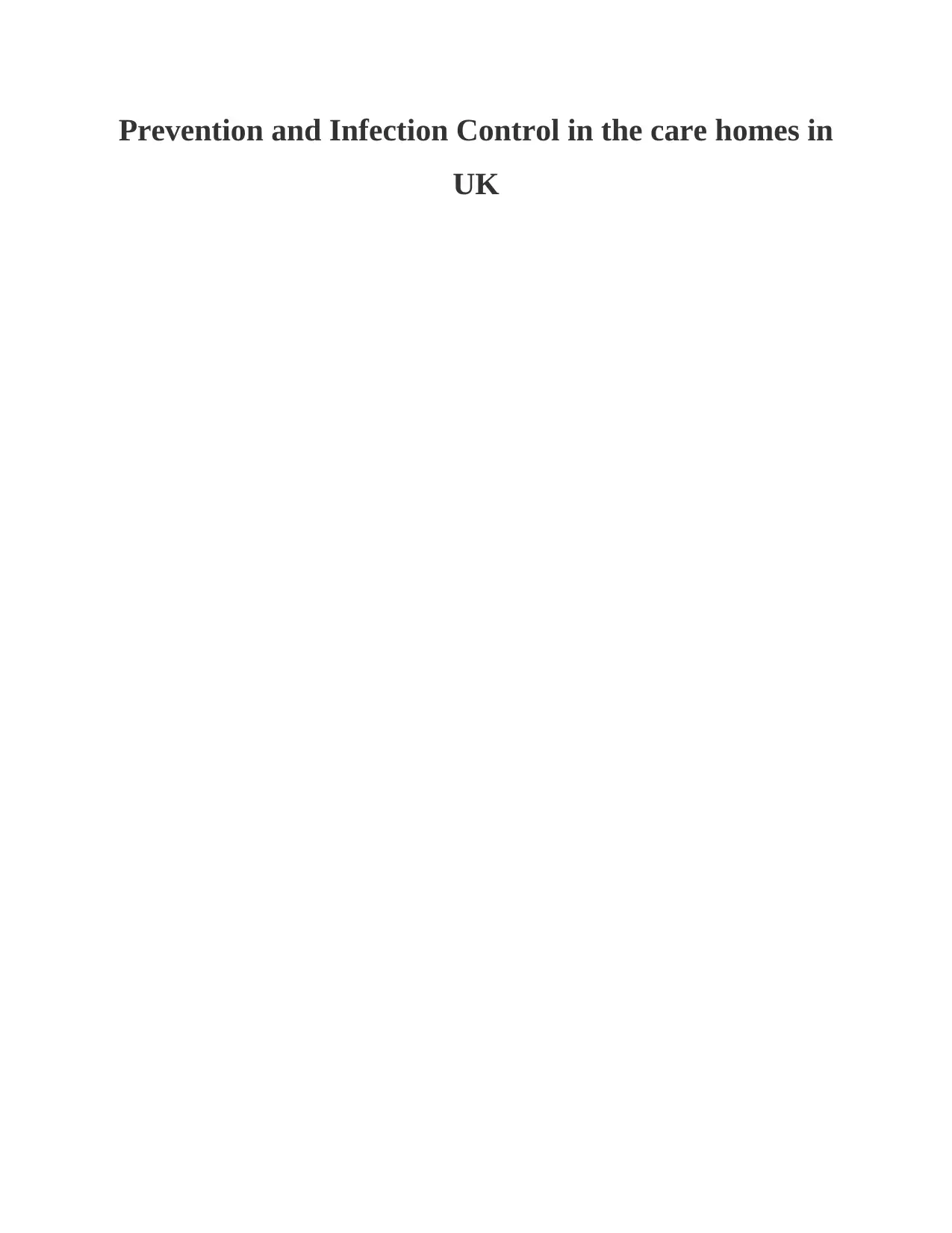
Prevention and Infection Control in the care homes in
UK
UK
Secure Best Marks with AI Grader
Need help grading? Try our AI Grader for instant feedback on your assignments.
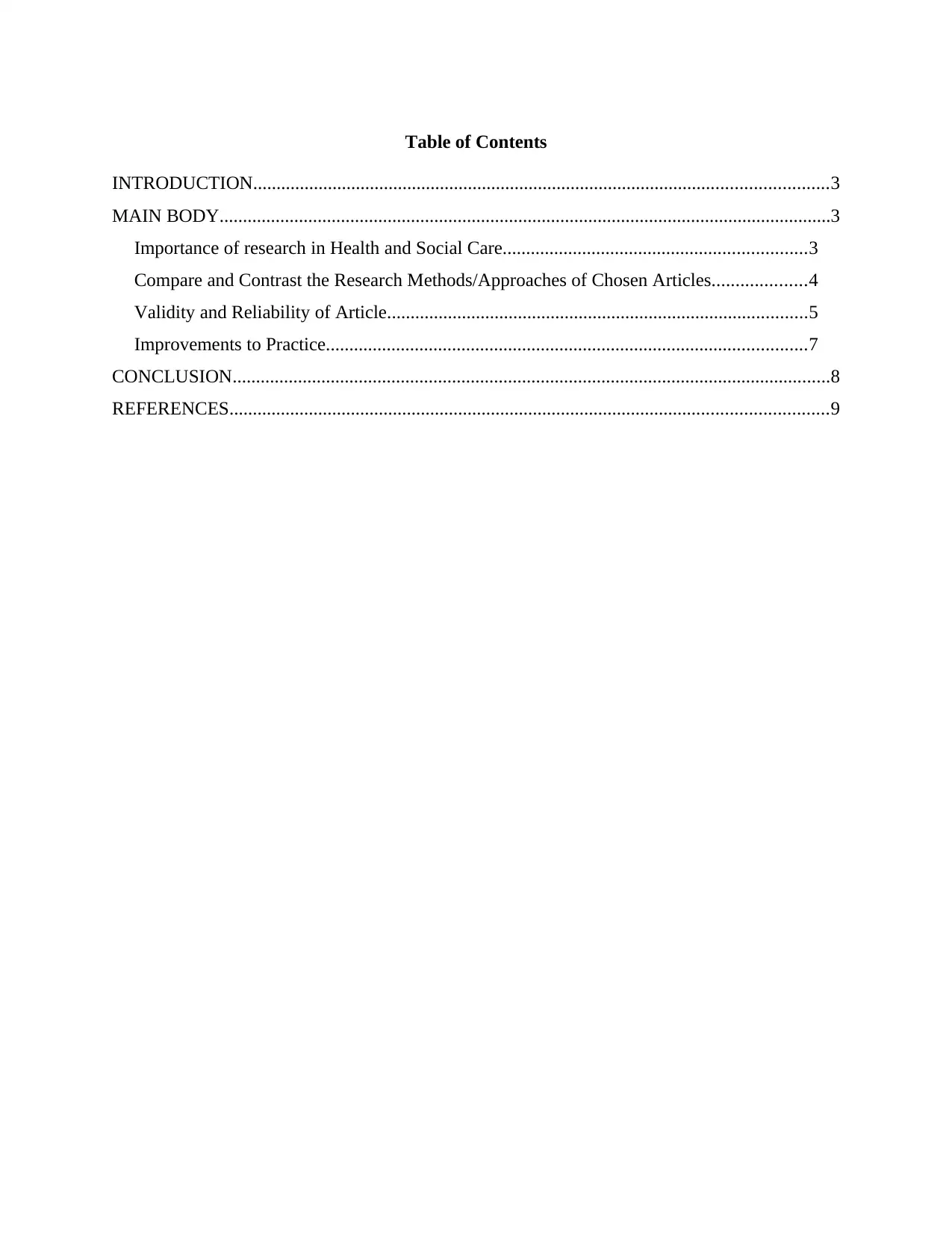
Table of Contents
INTRODUCTION...........................................................................................................................3
MAIN BODY...................................................................................................................................3
Importance of research in Health and Social Care.................................................................3
Compare and Contrast the Research Methods/Approaches of Chosen Articles....................4
Validity and Reliability of Article..........................................................................................5
Improvements to Practice.......................................................................................................7
CONCLUSION................................................................................................................................8
REFERENCES................................................................................................................................9
INTRODUCTION...........................................................................................................................3
MAIN BODY...................................................................................................................................3
Importance of research in Health and Social Care.................................................................3
Compare and Contrast the Research Methods/Approaches of Chosen Articles....................4
Validity and Reliability of Article..........................................................................................5
Improvements to Practice.......................................................................................................7
CONCLUSION................................................................................................................................8
REFERENCES................................................................................................................................9
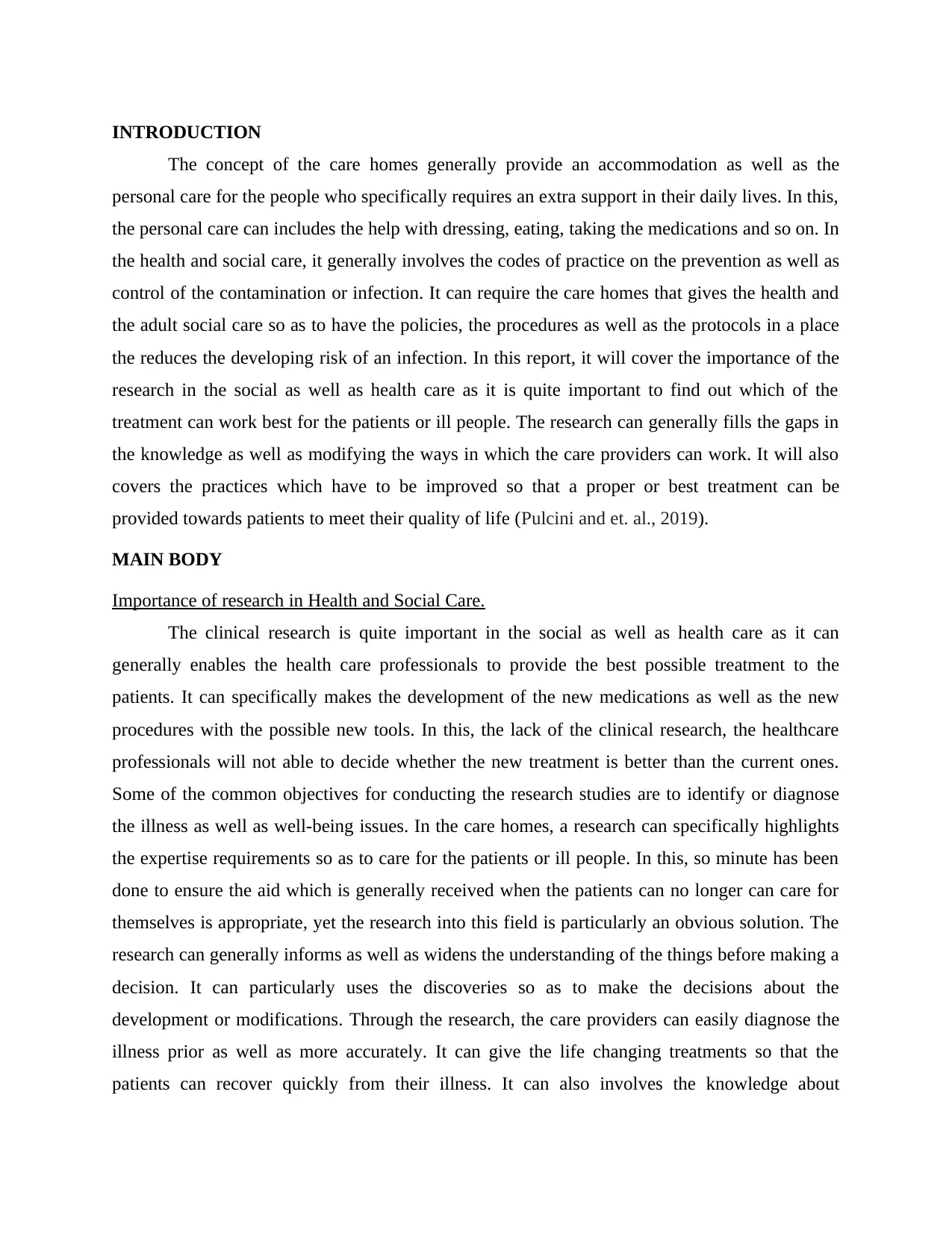
INTRODUCTION
The concept of the care homes generally provide an accommodation as well as the
personal care for the people who specifically requires an extra support in their daily lives. In this,
the personal care can includes the help with dressing, eating, taking the medications and so on. In
the health and social care, it generally involves the codes of practice on the prevention as well as
control of the contamination or infection. It can require the care homes that gives the health and
the adult social care so as to have the policies, the procedures as well as the protocols in a place
the reduces the developing risk of an infection. In this report, it will cover the importance of the
research in the social as well as health care as it is quite important to find out which of the
treatment can work best for the patients or ill people. The research can generally fills the gaps in
the knowledge as well as modifying the ways in which the care providers can work. It will also
covers the practices which have to be improved so that a proper or best treatment can be
provided towards patients to meet their quality of life (Pulcini and et. al., 2019).
MAIN BODY
Importance of research in Health and Social Care.
The clinical research is quite important in the social as well as health care as it can
generally enables the health care professionals to provide the best possible treatment to the
patients. It can specifically makes the development of the new medications as well as the new
procedures with the possible new tools. In this, the lack of the clinical research, the healthcare
professionals will not able to decide whether the new treatment is better than the current ones.
Some of the common objectives for conducting the research studies are to identify or diagnose
the illness as well as well-being issues. In the care homes, a research can specifically highlights
the expertise requirements so as to care for the patients or ill people. In this, so minute has been
done to ensure the aid which is generally received when the patients can no longer can care for
themselves is appropriate, yet the research into this field is particularly an obvious solution. The
research can generally informs as well as widens the understanding of the things before making a
decision. It can particularly uses the discoveries so as to make the decisions about the
development or modifications. Through the research, the care providers can easily diagnose the
illness prior as well as more accurately. It can give the life changing treatments so that the
patients can recover quickly from their illness. It can also involves the knowledge about
The concept of the care homes generally provide an accommodation as well as the
personal care for the people who specifically requires an extra support in their daily lives. In this,
the personal care can includes the help with dressing, eating, taking the medications and so on. In
the health and social care, it generally involves the codes of practice on the prevention as well as
control of the contamination or infection. It can require the care homes that gives the health and
the adult social care so as to have the policies, the procedures as well as the protocols in a place
the reduces the developing risk of an infection. In this report, it will cover the importance of the
research in the social as well as health care as it is quite important to find out which of the
treatment can work best for the patients or ill people. The research can generally fills the gaps in
the knowledge as well as modifying the ways in which the care providers can work. It will also
covers the practices which have to be improved so that a proper or best treatment can be
provided towards patients to meet their quality of life (Pulcini and et. al., 2019).
MAIN BODY
Importance of research in Health and Social Care.
The clinical research is quite important in the social as well as health care as it can
generally enables the health care professionals to provide the best possible treatment to the
patients. It can specifically makes the development of the new medications as well as the new
procedures with the possible new tools. In this, the lack of the clinical research, the healthcare
professionals will not able to decide whether the new treatment is better than the current ones.
Some of the common objectives for conducting the research studies are to identify or diagnose
the illness as well as well-being issues. In the care homes, a research can specifically highlights
the expertise requirements so as to care for the patients or ill people. In this, so minute has been
done to ensure the aid which is generally received when the patients can no longer can care for
themselves is appropriate, yet the research into this field is particularly an obvious solution. The
research can generally informs as well as widens the understanding of the things before making a
decision. It can particularly uses the discoveries so as to make the decisions about the
development or modifications. Through the research, the care providers can easily diagnose the
illness prior as well as more accurately. It can give the life changing treatments so that the
patients can recover quickly from their illness. It can also involves the knowledge about
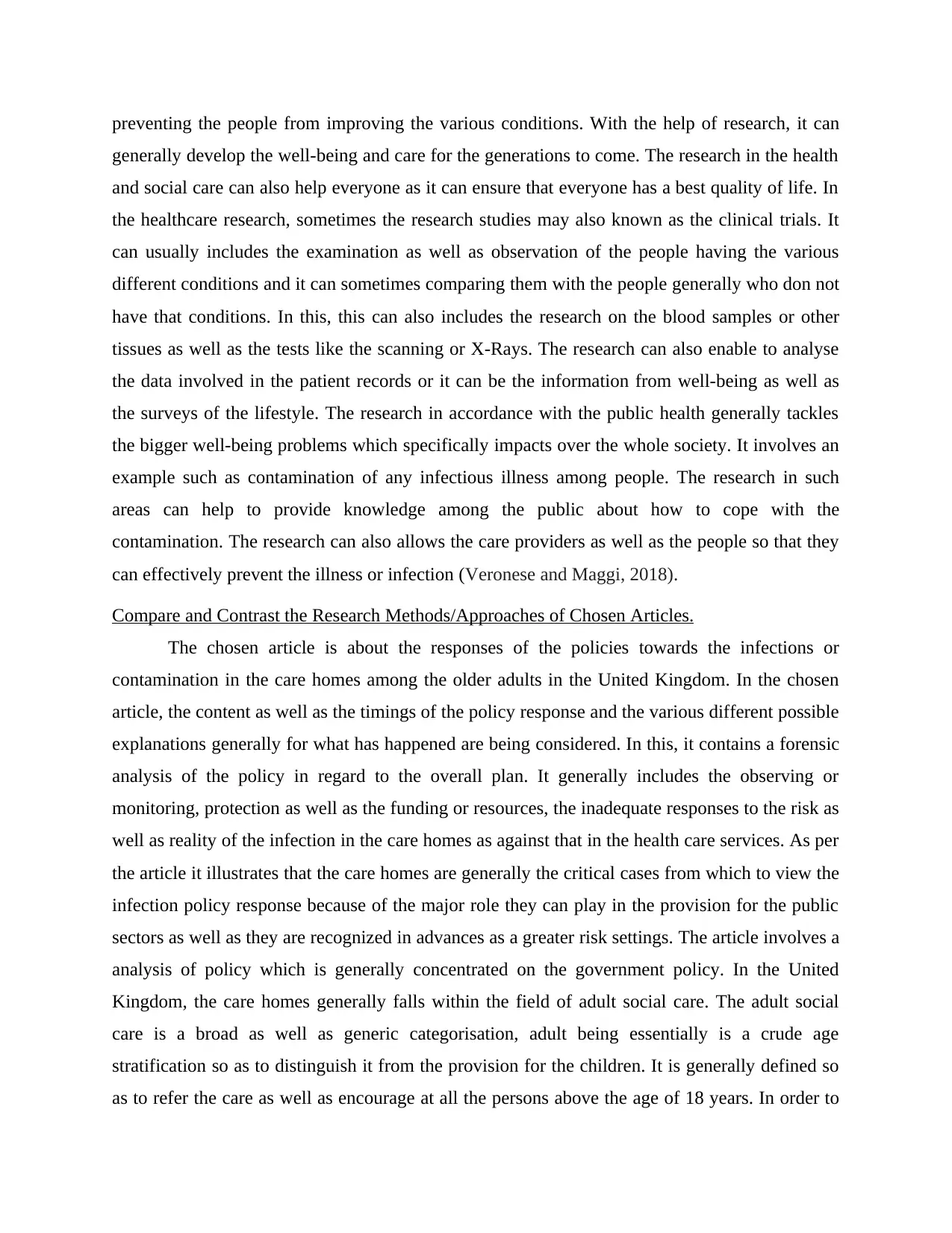
preventing the people from improving the various conditions. With the help of research, it can
generally develop the well-being and care for the generations to come. The research in the health
and social care can also help everyone as it can ensure that everyone has a best quality of life. In
the healthcare research, sometimes the research studies may also known as the clinical trials. It
can usually includes the examination as well as observation of the people having the various
different conditions and it can sometimes comparing them with the people generally who don not
have that conditions. In this, this can also includes the research on the blood samples or other
tissues as well as the tests like the scanning or X-Rays. The research can also enable to analyse
the data involved in the patient records or it can be the information from well-being as well as
the surveys of the lifestyle. The research in accordance with the public health generally tackles
the bigger well-being problems which specifically impacts over the whole society. It involves an
example such as contamination of any infectious illness among people. The research in such
areas can help to provide knowledge among the public about how to cope with the
contamination. The research can also allows the care providers as well as the people so that they
can effectively prevent the illness or infection (Veronese and Maggi, 2018).
Compare and Contrast the Research Methods/Approaches of Chosen Articles.
The chosen article is about the responses of the policies towards the infections or
contamination in the care homes among the older adults in the United Kingdom. In the chosen
article, the content as well as the timings of the policy response and the various different possible
explanations generally for what has happened are being considered. In this, it contains a forensic
analysis of the policy in regard to the overall plan. It generally includes the observing or
monitoring, protection as well as the funding or resources, the inadequate responses to the risk as
well as reality of the infection in the care homes as against that in the health care services. As per
the article it illustrates that the care homes are generally the critical cases from which to view the
infection policy response because of the major role they can play in the provision for the public
sectors as well as they are recognized in advances as a greater risk settings. The article involves a
analysis of policy which is generally concentrated on the government policy. In the United
Kingdom, the care homes generally falls within the field of adult social care. The adult social
care is a broad as well as generic categorisation, adult being essentially is a crude age
stratification so as to distinguish it from the provision for the children. It is generally defined so
as to refer the care as well as encourage at all the persons above the age of 18 years. In order to
generally develop the well-being and care for the generations to come. The research in the health
and social care can also help everyone as it can ensure that everyone has a best quality of life. In
the healthcare research, sometimes the research studies may also known as the clinical trials. It
can usually includes the examination as well as observation of the people having the various
different conditions and it can sometimes comparing them with the people generally who don not
have that conditions. In this, this can also includes the research on the blood samples or other
tissues as well as the tests like the scanning or X-Rays. The research can also enable to analyse
the data involved in the patient records or it can be the information from well-being as well as
the surveys of the lifestyle. The research in accordance with the public health generally tackles
the bigger well-being problems which specifically impacts over the whole society. It involves an
example such as contamination of any infectious illness among people. The research in such
areas can help to provide knowledge among the public about how to cope with the
contamination. The research can also allows the care providers as well as the people so that they
can effectively prevent the illness or infection (Veronese and Maggi, 2018).
Compare and Contrast the Research Methods/Approaches of Chosen Articles.
The chosen article is about the responses of the policies towards the infections or
contamination in the care homes among the older adults in the United Kingdom. In the chosen
article, the content as well as the timings of the policy response and the various different possible
explanations generally for what has happened are being considered. In this, it contains a forensic
analysis of the policy in regard to the overall plan. It generally includes the observing or
monitoring, protection as well as the funding or resources, the inadequate responses to the risk as
well as reality of the infection in the care homes as against that in the health care services. As per
the article it illustrates that the care homes are generally the critical cases from which to view the
infection policy response because of the major role they can play in the provision for the public
sectors as well as they are recognized in advances as a greater risk settings. The article involves a
analysis of policy which is generally concentrated on the government policy. In the United
Kingdom, the care homes generally falls within the field of adult social care. The adult social
care is a broad as well as generic categorisation, adult being essentially is a crude age
stratification so as to distinguish it from the provision for the children. It is generally defined so
as to refer the care as well as encourage at all the persons above the age of 18 years. In order to
Secure Best Marks with AI Grader
Need help grading? Try our AI Grader for instant feedback on your assignments.
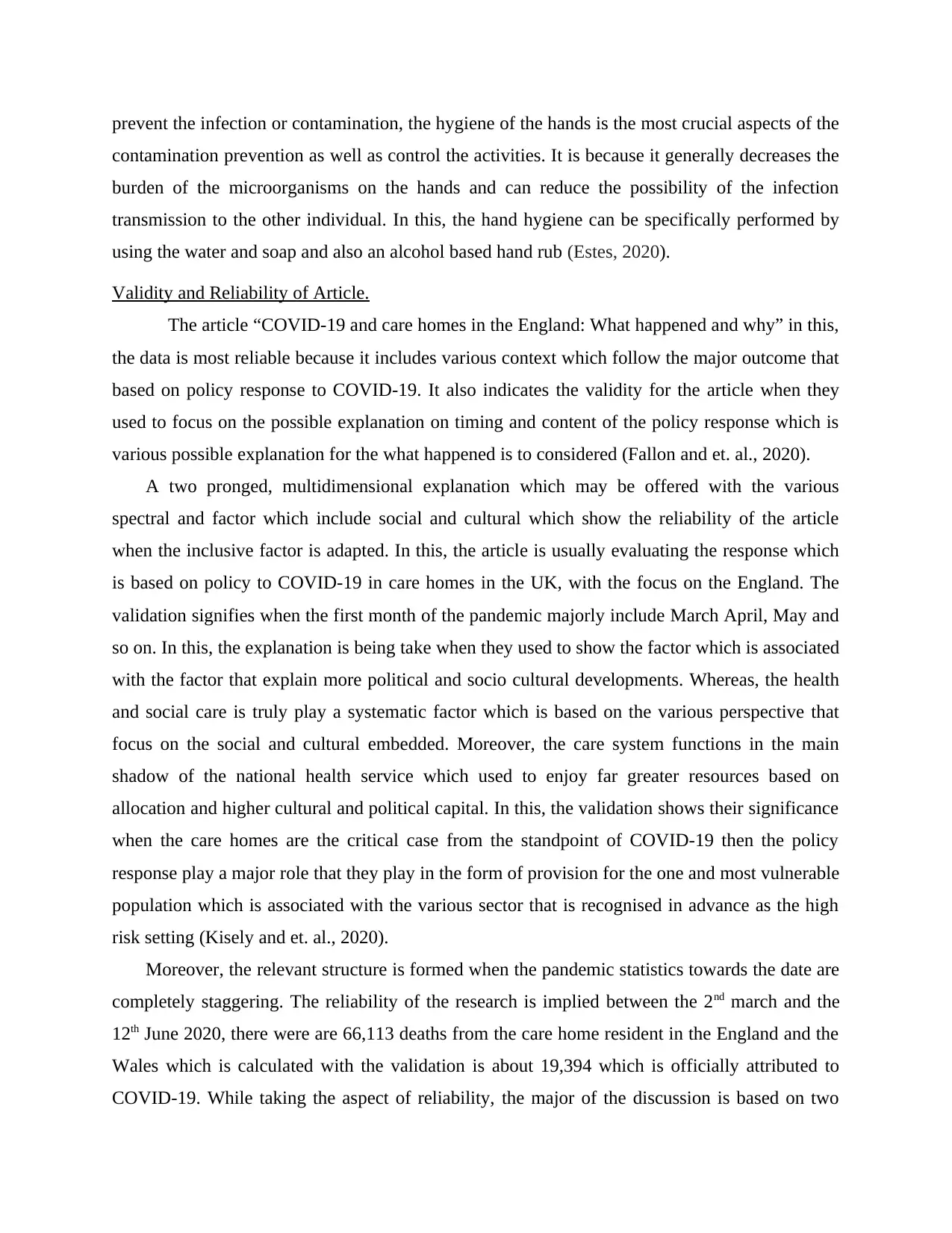
prevent the infection or contamination, the hygiene of the hands is the most crucial aspects of the
contamination prevention as well as control the activities. It is because it generally decreases the
burden of the microorganisms on the hands and can reduce the possibility of the infection
transmission to the other individual. In this, the hand hygiene can be specifically performed by
using the water and soap and also an alcohol based hand rub (Estes, 2020).
Validity and Reliability of Article.
The article “COVID-19 and care homes in the England: What happened and why” in this,
the data is most reliable because it includes various context which follow the major outcome that
based on policy response to COVID-19. It also indicates the validity for the article when they
used to focus on the possible explanation on timing and content of the policy response which is
various possible explanation for the what happened is to considered (Fallon and et. al., 2020).
A two pronged, multidimensional explanation which may be offered with the various
spectral and factor which include social and cultural which show the reliability of the article
when the inclusive factor is adapted. In this, the article is usually evaluating the response which
is based on policy to COVID-19 in care homes in the UK, with the focus on the England. The
validation signifies when the first month of the pandemic majorly include March April, May and
so on. In this, the explanation is being take when they used to show the factor which is associated
with the factor that explain more political and socio cultural developments. Whereas, the health
and social care is truly play a systematic factor which is based on the various perspective that
focus on the social and cultural embedded. Moreover, the care system functions in the main
shadow of the national health service which used to enjoy far greater resources based on
allocation and higher cultural and political capital. In this, the validation shows their significance
when the care homes are the critical case from the standpoint of COVID-19 then the policy
response play a major role that they play in the form of provision for the one and most vulnerable
population which is associated with the various sector that is recognised in advance as the high
risk setting (Kisely and et. al., 2020).
Moreover, the relevant structure is formed when the pandemic statistics towards the date are
completely staggering. The reliability of the research is implied between the 2nd march and the
12th June 2020, there were are 66,113 deaths from the care home resident in the England and the
Wales which is calculated with the validation is about 19,394 which is officially attributed to
COVID-19. While taking the aspect of reliability, the major of the discussion is based on two
contamination prevention as well as control the activities. It is because it generally decreases the
burden of the microorganisms on the hands and can reduce the possibility of the infection
transmission to the other individual. In this, the hand hygiene can be specifically performed by
using the water and soap and also an alcohol based hand rub (Estes, 2020).
Validity and Reliability of Article.
The article “COVID-19 and care homes in the England: What happened and why” in this,
the data is most reliable because it includes various context which follow the major outcome that
based on policy response to COVID-19. It also indicates the validity for the article when they
used to focus on the possible explanation on timing and content of the policy response which is
various possible explanation for the what happened is to considered (Fallon and et. al., 2020).
A two pronged, multidimensional explanation which may be offered with the various
spectral and factor which include social and cultural which show the reliability of the article
when the inclusive factor is adapted. In this, the article is usually evaluating the response which
is based on policy to COVID-19 in care homes in the UK, with the focus on the England. The
validation signifies when the first month of the pandemic majorly include March April, May and
so on. In this, the explanation is being take when they used to show the factor which is associated
with the factor that explain more political and socio cultural developments. Whereas, the health
and social care is truly play a systematic factor which is based on the various perspective that
focus on the social and cultural embedded. Moreover, the care system functions in the main
shadow of the national health service which used to enjoy far greater resources based on
allocation and higher cultural and political capital. In this, the validation shows their significance
when the care homes are the critical case from the standpoint of COVID-19 then the policy
response play a major role that they play in the form of provision for the one and most vulnerable
population which is associated with the various sector that is recognised in advance as the high
risk setting (Kisely and et. al., 2020).
Moreover, the relevant structure is formed when the pandemic statistics towards the date are
completely staggering. The reliability of the research is implied between the 2nd march and the
12th June 2020, there were are 66,113 deaths from the care home resident in the England and the
Wales which is calculated with the validation is about 19,394 which is officially attributed to
COVID-19. While taking the aspect of reliability, the major of the discussion is based on two
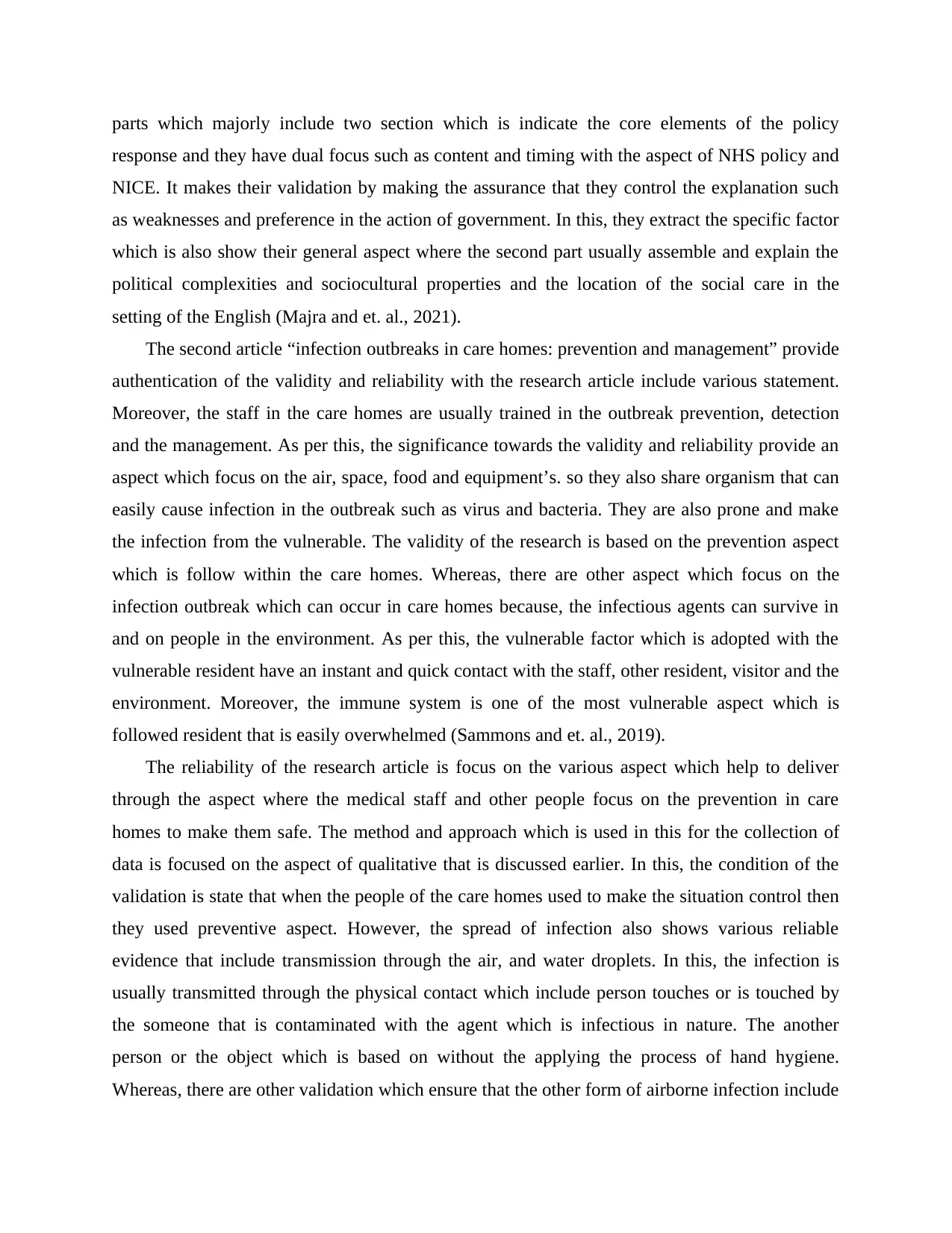
parts which majorly include two section which is indicate the core elements of the policy
response and they have dual focus such as content and timing with the aspect of NHS policy and
NICE. It makes their validation by making the assurance that they control the explanation such
as weaknesses and preference in the action of government. In this, they extract the specific factor
which is also show their general aspect where the second part usually assemble and explain the
political complexities and sociocultural properties and the location of the social care in the
setting of the English (Majra and et. al., 2021).
The second article “infection outbreaks in care homes: prevention and management” provide
authentication of the validity and reliability with the research article include various statement.
Moreover, the staff in the care homes are usually trained in the outbreak prevention, detection
and the management. As per this, the significance towards the validity and reliability provide an
aspect which focus on the air, space, food and equipment’s. so they also share organism that can
easily cause infection in the outbreak such as virus and bacteria. They are also prone and make
the infection from the vulnerable. The validity of the research is based on the prevention aspect
which is follow within the care homes. Whereas, there are other aspect which focus on the
infection outbreak which can occur in care homes because, the infectious agents can survive in
and on people in the environment. As per this, the vulnerable factor which is adopted with the
vulnerable resident have an instant and quick contact with the staff, other resident, visitor and the
environment. Moreover, the immune system is one of the most vulnerable aspect which is
followed resident that is easily overwhelmed (Sammons and et. al., 2019).
The reliability of the research article is focus on the various aspect which help to deliver
through the aspect where the medical staff and other people focus on the prevention in care
homes to make them safe. The method and approach which is used in this for the collection of
data is focused on the aspect of qualitative that is discussed earlier. In this, the condition of the
validation is state that when the people of the care homes used to make the situation control then
they used preventive aspect. However, the spread of infection also shows various reliable
evidence that include transmission through the air, and water droplets. In this, the infection is
usually transmitted through the physical contact which include person touches or is touched by
the someone that is contaminated with the agent which is infectious in nature. The another
person or the object which is based on without the applying the process of hand hygiene.
Whereas, there are other validation which ensure that the other form of airborne infection include
response and they have dual focus such as content and timing with the aspect of NHS policy and
NICE. It makes their validation by making the assurance that they control the explanation such
as weaknesses and preference in the action of government. In this, they extract the specific factor
which is also show their general aspect where the second part usually assemble and explain the
political complexities and sociocultural properties and the location of the social care in the
setting of the English (Majra and et. al., 2021).
The second article “infection outbreaks in care homes: prevention and management” provide
authentication of the validity and reliability with the research article include various statement.
Moreover, the staff in the care homes are usually trained in the outbreak prevention, detection
and the management. As per this, the significance towards the validity and reliability provide an
aspect which focus on the air, space, food and equipment’s. so they also share organism that can
easily cause infection in the outbreak such as virus and bacteria. They are also prone and make
the infection from the vulnerable. The validity of the research is based on the prevention aspect
which is follow within the care homes. Whereas, there are other aspect which focus on the
infection outbreak which can occur in care homes because, the infectious agents can survive in
and on people in the environment. As per this, the vulnerable factor which is adopted with the
vulnerable resident have an instant and quick contact with the staff, other resident, visitor and the
environment. Moreover, the immune system is one of the most vulnerable aspect which is
followed resident that is easily overwhelmed (Sammons and et. al., 2019).
The reliability of the research article is focus on the various aspect which help to deliver
through the aspect where the medical staff and other people focus on the prevention in care
homes to make them safe. The method and approach which is used in this for the collection of
data is focused on the aspect of qualitative that is discussed earlier. In this, the condition of the
validation is state that when the people of the care homes used to make the situation control then
they used preventive aspect. However, the spread of infection also shows various reliable
evidence that include transmission through the air, and water droplets. In this, the infection is
usually transmitted through the physical contact which include person touches or is touched by
the someone that is contaminated with the agent which is infectious in nature. The another
person or the object which is based on without the applying the process of hand hygiene.
Whereas, there are other validation which ensure that the other form of airborne infection include
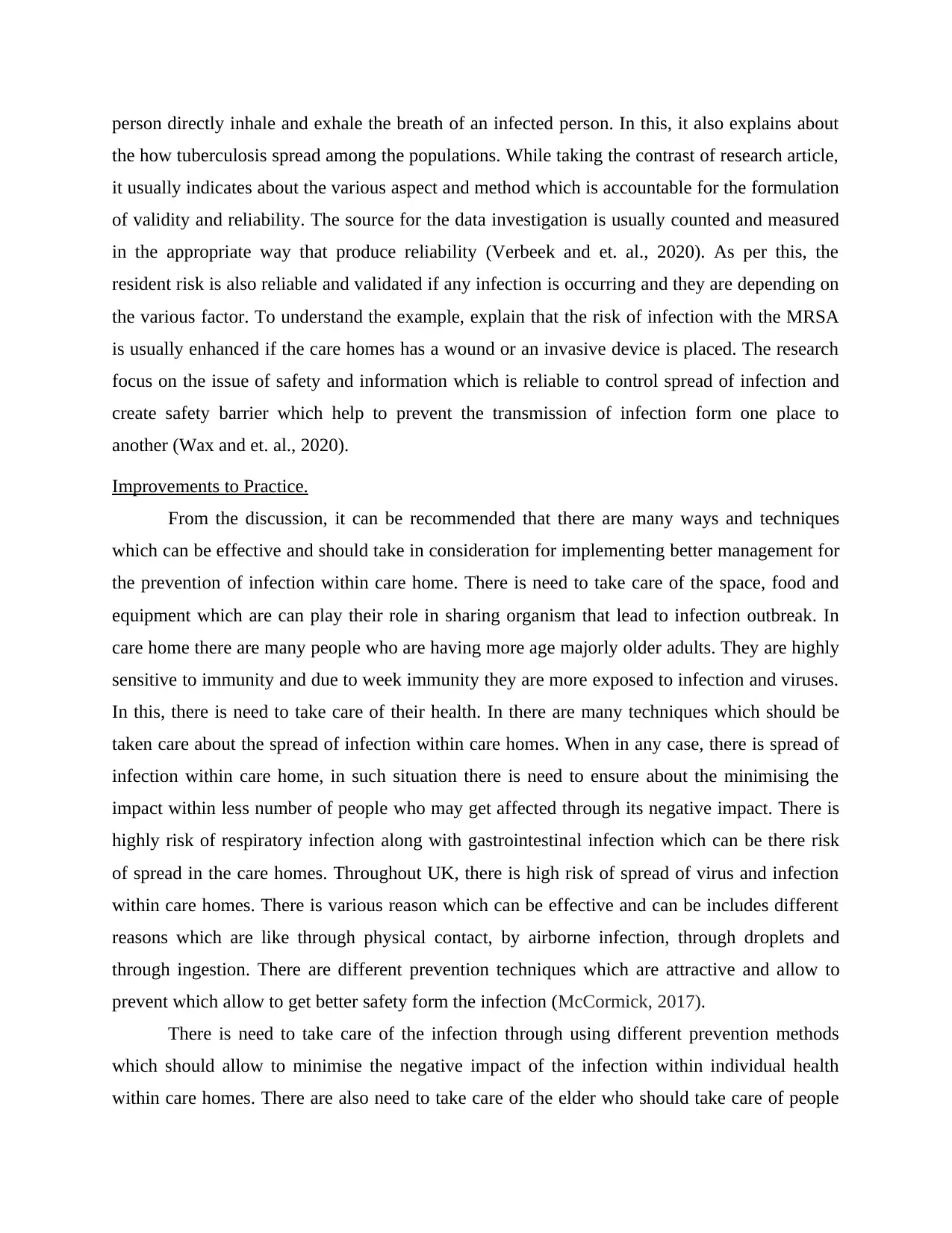
person directly inhale and exhale the breath of an infected person. In this, it also explains about
the how tuberculosis spread among the populations. While taking the contrast of research article,
it usually indicates about the various aspect and method which is accountable for the formulation
of validity and reliability. The source for the data investigation is usually counted and measured
in the appropriate way that produce reliability (Verbeek and et. al., 2020). As per this, the
resident risk is also reliable and validated if any infection is occurring and they are depending on
the various factor. To understand the example, explain that the risk of infection with the MRSA
is usually enhanced if the care homes has a wound or an invasive device is placed. The research
focus on the issue of safety and information which is reliable to control spread of infection and
create safety barrier which help to prevent the transmission of infection form one place to
another (Wax and et. al., 2020).
Improvements to Practice.
From the discussion, it can be recommended that there are many ways and techniques
which can be effective and should take in consideration for implementing better management for
the prevention of infection within care home. There is need to take care of the space, food and
equipment which are can play their role in sharing organism that lead to infection outbreak. In
care home there are many people who are having more age majorly older adults. They are highly
sensitive to immunity and due to week immunity they are more exposed to infection and viruses.
In this, there is need to take care of their health. In there are many techniques which should be
taken care about the spread of infection within care homes. When in any case, there is spread of
infection within care home, in such situation there is need to ensure about the minimising the
impact within less number of people who may get affected through its negative impact. There is
highly risk of respiratory infection along with gastrointestinal infection which can be there risk
of spread in the care homes. Throughout UK, there is high risk of spread of virus and infection
within care homes. There is various reason which can be effective and can be includes different
reasons which are like through physical contact, by airborne infection, through droplets and
through ingestion. There are different prevention techniques which are attractive and allow to
prevent which allow to get better safety form the infection (McCormick, 2017).
There is need to take care of the infection through using different prevention methods
which should allow to minimise the negative impact of the infection within individual health
within care homes. There are also need to take care of the elder who should take care of people
the how tuberculosis spread among the populations. While taking the contrast of research article,
it usually indicates about the various aspect and method which is accountable for the formulation
of validity and reliability. The source for the data investigation is usually counted and measured
in the appropriate way that produce reliability (Verbeek and et. al., 2020). As per this, the
resident risk is also reliable and validated if any infection is occurring and they are depending on
the various factor. To understand the example, explain that the risk of infection with the MRSA
is usually enhanced if the care homes has a wound or an invasive device is placed. The research
focus on the issue of safety and information which is reliable to control spread of infection and
create safety barrier which help to prevent the transmission of infection form one place to
another (Wax and et. al., 2020).
Improvements to Practice.
From the discussion, it can be recommended that there are many ways and techniques
which can be effective and should take in consideration for implementing better management for
the prevention of infection within care home. There is need to take care of the space, food and
equipment which are can play their role in sharing organism that lead to infection outbreak. In
care home there are many people who are having more age majorly older adults. They are highly
sensitive to immunity and due to week immunity they are more exposed to infection and viruses.
In this, there is need to take care of their health. In there are many techniques which should be
taken care about the spread of infection within care homes. When in any case, there is spread of
infection within care home, in such situation there is need to ensure about the minimising the
impact within less number of people who may get affected through its negative impact. There is
highly risk of respiratory infection along with gastrointestinal infection which can be there risk
of spread in the care homes. Throughout UK, there is high risk of spread of virus and infection
within care homes. There is various reason which can be effective and can be includes different
reasons which are like through physical contact, by airborne infection, through droplets and
through ingestion. There are different prevention techniques which are attractive and allow to
prevent which allow to get better safety form the infection (McCormick, 2017).
There is need to take care of the infection through using different prevention methods
which should allow to minimise the negative impact of the infection within individual health
within care homes. There are also need to take care of the elder who should take care of people
Paraphrase This Document
Need a fresh take? Get an instant paraphrase of this document with our AI Paraphraser
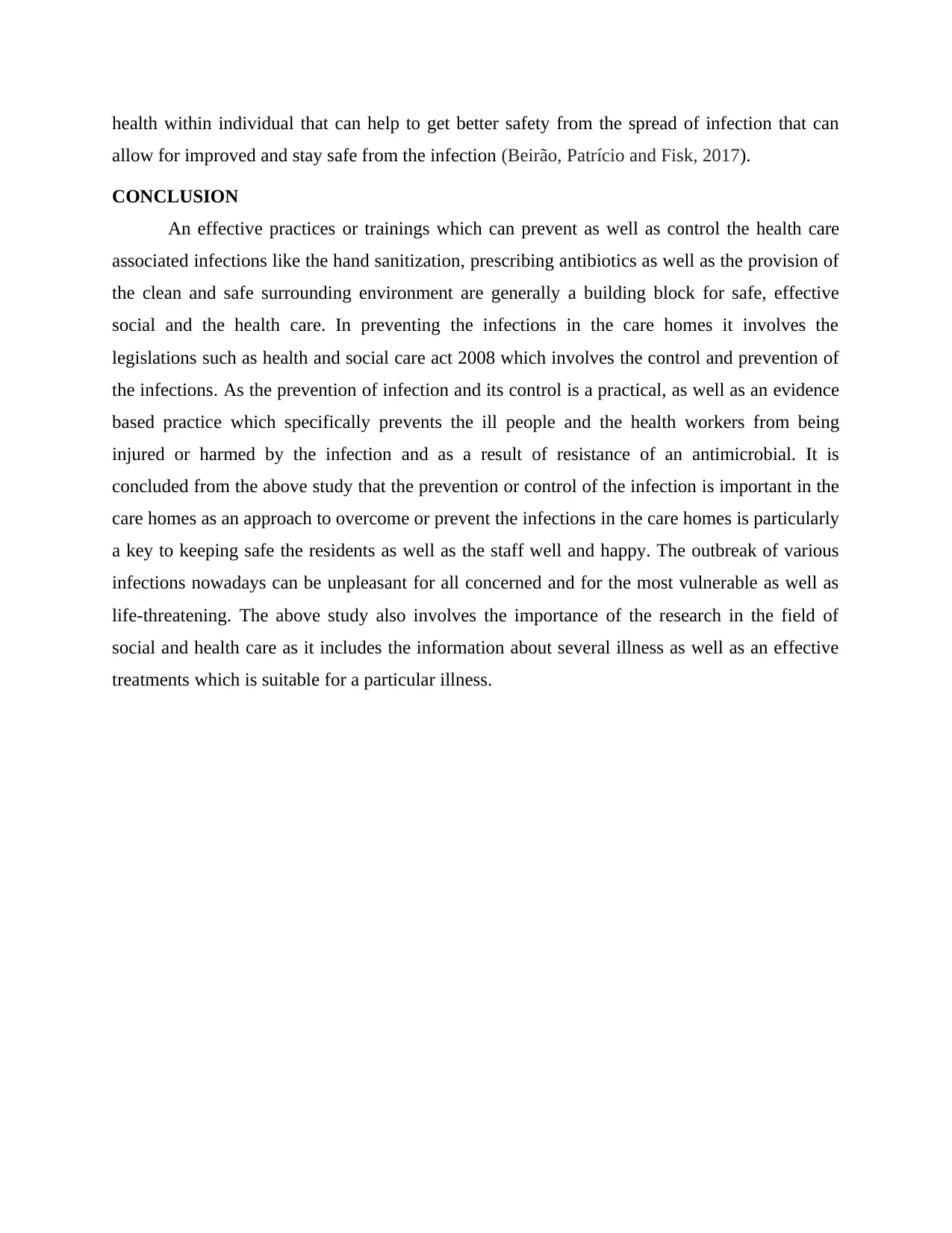
health within individual that can help to get better safety from the spread of infection that can
allow for improved and stay safe from the infection (Beirão, Patrício and Fisk, 2017).
CONCLUSION
An effective practices or trainings which can prevent as well as control the health care
associated infections like the hand sanitization, prescribing antibiotics as well as the provision of
the clean and safe surrounding environment are generally a building block for safe, effective
social and the health care. In preventing the infections in the care homes it involves the
legislations such as health and social care act 2008 which involves the control and prevention of
the infections. As the prevention of infection and its control is a practical, as well as an evidence
based practice which specifically prevents the ill people and the health workers from being
injured or harmed by the infection and as a result of resistance of an antimicrobial. It is
concluded from the above study that the prevention or control of the infection is important in the
care homes as an approach to overcome or prevent the infections in the care homes is particularly
a key to keeping safe the residents as well as the staff well and happy. The outbreak of various
infections nowadays can be unpleasant for all concerned and for the most vulnerable as well as
life-threatening. The above study also involves the importance of the research in the field of
social and health care as it includes the information about several illness as well as an effective
treatments which is suitable for a particular illness.
allow for improved and stay safe from the infection (Beirão, Patrício and Fisk, 2017).
CONCLUSION
An effective practices or trainings which can prevent as well as control the health care
associated infections like the hand sanitization, prescribing antibiotics as well as the provision of
the clean and safe surrounding environment are generally a building block for safe, effective
social and the health care. In preventing the infections in the care homes it involves the
legislations such as health and social care act 2008 which involves the control and prevention of
the infections. As the prevention of infection and its control is a practical, as well as an evidence
based practice which specifically prevents the ill people and the health workers from being
injured or harmed by the infection and as a result of resistance of an antimicrobial. It is
concluded from the above study that the prevention or control of the infection is important in the
care homes as an approach to overcome or prevent the infections in the care homes is particularly
a key to keeping safe the residents as well as the staff well and happy. The outbreak of various
infections nowadays can be unpleasant for all concerned and for the most vulnerable as well as
life-threatening. The above study also involves the importance of the research in the field of
social and health care as it includes the information about several illness as well as an effective
treatments which is suitable for a particular illness.
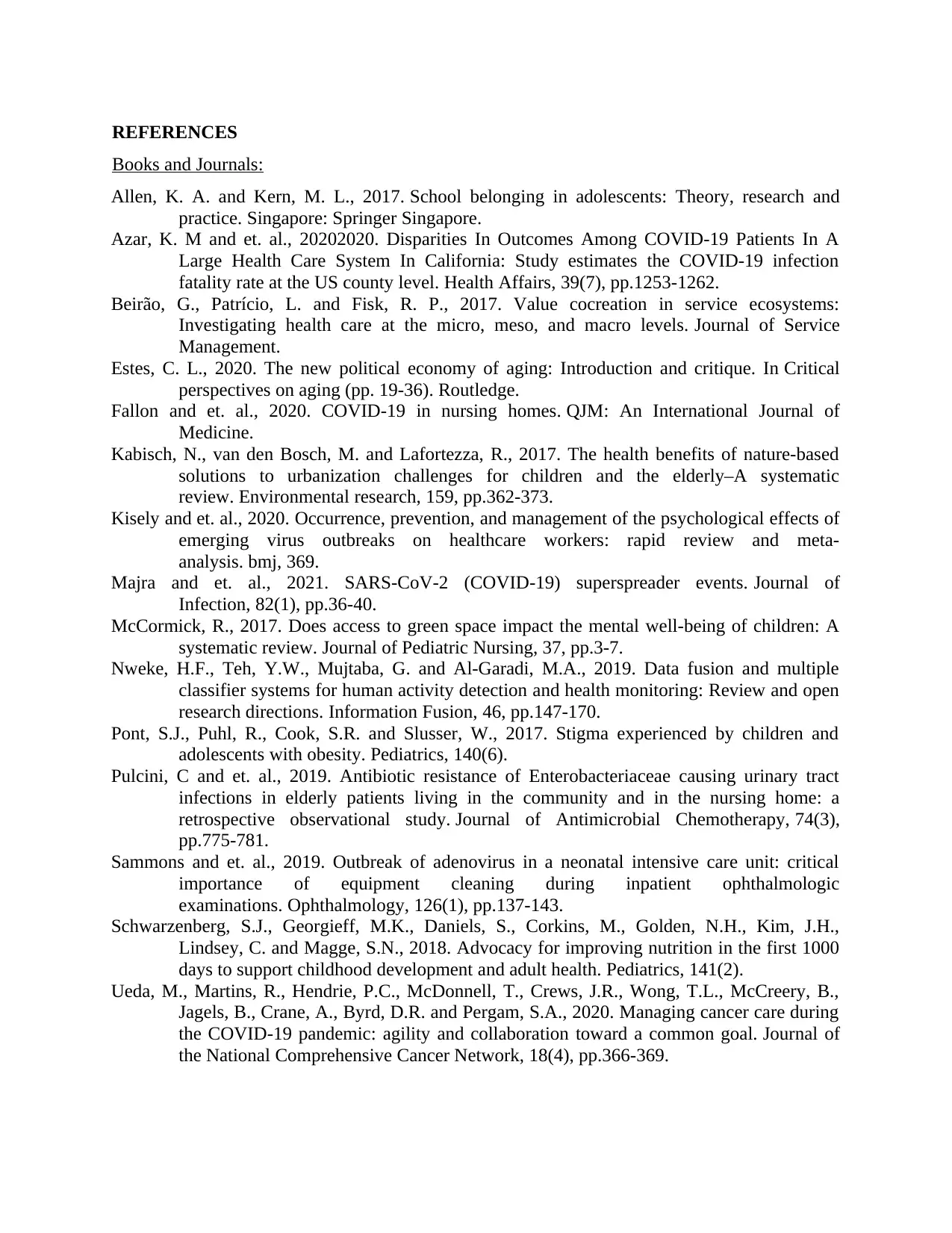
REFERENCES
Books and Journals:
Allen, K. A. and Kern, M. L., 2017. School belonging in adolescents: Theory, research and
practice. Singapore: Springer Singapore.
Azar, K. M and et. al., 20202020. Disparities In Outcomes Among COVID-19 Patients In A
Large Health Care System In California: Study estimates the COVID-19 infection
fatality rate at the US county level. Health Affairs, 39(7), pp.1253-1262.
Beirão, G., Patrício, L. and Fisk, R. P., 2017. Value cocreation in service ecosystems:
Investigating health care at the micro, meso, and macro levels. Journal of Service
Management.
Estes, C. L., 2020. The new political economy of aging: Introduction and critique. In Critical
perspectives on aging (pp. 19-36). Routledge.
Fallon and et. al., 2020. COVID-19 in nursing homes. QJM: An International Journal of
Medicine.
Kabisch, N., van den Bosch, M. and Lafortezza, R., 2017. The health benefits of nature-based
solutions to urbanization challenges for children and the elderly–A systematic
review. Environmental research, 159, pp.362-373.
Kisely and et. al., 2020. Occurrence, prevention, and management of the psychological effects of
emerging virus outbreaks on healthcare workers: rapid review and meta-
analysis. bmj, 369.
Majra and et. al., 2021. SARS-CoV-2 (COVID-19) superspreader events. Journal of
Infection, 82(1), pp.36-40.
McCormick, R., 2017. Does access to green space impact the mental well-being of children: A
systematic review. Journal of Pediatric Nursing, 37, pp.3-7.
Nweke, H.F., Teh, Y.W., Mujtaba, G. and Al-Garadi, M.A., 2019. Data fusion and multiple
classifier systems for human activity detection and health monitoring: Review and open
research directions. Information Fusion, 46, pp.147-170.
Pont, S.J., Puhl, R., Cook, S.R. and Slusser, W., 2017. Stigma experienced by children and
adolescents with obesity. Pediatrics, 140(6).
Pulcini, C and et. al., 2019. Antibiotic resistance of Enterobacteriaceae causing urinary tract
infections in elderly patients living in the community and in the nursing home: a
retrospective observational study. Journal of Antimicrobial Chemotherapy, 74(3),
pp.775-781.
Sammons and et. al., 2019. Outbreak of adenovirus in a neonatal intensive care unit: critical
importance of equipment cleaning during inpatient ophthalmologic
examinations. Ophthalmology, 126(1), pp.137-143.
Schwarzenberg, S.J., Georgieff, M.K., Daniels, S., Corkins, M., Golden, N.H., Kim, J.H.,
Lindsey, C. and Magge, S.N., 2018. Advocacy for improving nutrition in the first 1000
days to support childhood development and adult health. Pediatrics, 141(2).
Ueda, M., Martins, R., Hendrie, P.C., McDonnell, T., Crews, J.R., Wong, T.L., McCreery, B.,
Jagels, B., Crane, A., Byrd, D.R. and Pergam, S.A., 2020. Managing cancer care during
the COVID-19 pandemic: agility and collaboration toward a common goal. Journal of
the National Comprehensive Cancer Network, 18(4), pp.366-369.
Books and Journals:
Allen, K. A. and Kern, M. L., 2017. School belonging in adolescents: Theory, research and
practice. Singapore: Springer Singapore.
Azar, K. M and et. al., 20202020. Disparities In Outcomes Among COVID-19 Patients In A
Large Health Care System In California: Study estimates the COVID-19 infection
fatality rate at the US county level. Health Affairs, 39(7), pp.1253-1262.
Beirão, G., Patrício, L. and Fisk, R. P., 2017. Value cocreation in service ecosystems:
Investigating health care at the micro, meso, and macro levels. Journal of Service
Management.
Estes, C. L., 2020. The new political economy of aging: Introduction and critique. In Critical
perspectives on aging (pp. 19-36). Routledge.
Fallon and et. al., 2020. COVID-19 in nursing homes. QJM: An International Journal of
Medicine.
Kabisch, N., van den Bosch, M. and Lafortezza, R., 2017. The health benefits of nature-based
solutions to urbanization challenges for children and the elderly–A systematic
review. Environmental research, 159, pp.362-373.
Kisely and et. al., 2020. Occurrence, prevention, and management of the psychological effects of
emerging virus outbreaks on healthcare workers: rapid review and meta-
analysis. bmj, 369.
Majra and et. al., 2021. SARS-CoV-2 (COVID-19) superspreader events. Journal of
Infection, 82(1), pp.36-40.
McCormick, R., 2017. Does access to green space impact the mental well-being of children: A
systematic review. Journal of Pediatric Nursing, 37, pp.3-7.
Nweke, H.F., Teh, Y.W., Mujtaba, G. and Al-Garadi, M.A., 2019. Data fusion and multiple
classifier systems for human activity detection and health monitoring: Review and open
research directions. Information Fusion, 46, pp.147-170.
Pont, S.J., Puhl, R., Cook, S.R. and Slusser, W., 2017. Stigma experienced by children and
adolescents with obesity. Pediatrics, 140(6).
Pulcini, C and et. al., 2019. Antibiotic resistance of Enterobacteriaceae causing urinary tract
infections in elderly patients living in the community and in the nursing home: a
retrospective observational study. Journal of Antimicrobial Chemotherapy, 74(3),
pp.775-781.
Sammons and et. al., 2019. Outbreak of adenovirus in a neonatal intensive care unit: critical
importance of equipment cleaning during inpatient ophthalmologic
examinations. Ophthalmology, 126(1), pp.137-143.
Schwarzenberg, S.J., Georgieff, M.K., Daniels, S., Corkins, M., Golden, N.H., Kim, J.H.,
Lindsey, C. and Magge, S.N., 2018. Advocacy for improving nutrition in the first 1000
days to support childhood development and adult health. Pediatrics, 141(2).
Ueda, M., Martins, R., Hendrie, P.C., McDonnell, T., Crews, J.R., Wong, T.L., McCreery, B.,
Jagels, B., Crane, A., Byrd, D.R. and Pergam, S.A., 2020. Managing cancer care during
the COVID-19 pandemic: agility and collaboration toward a common goal. Journal of
the National Comprehensive Cancer Network, 18(4), pp.366-369.
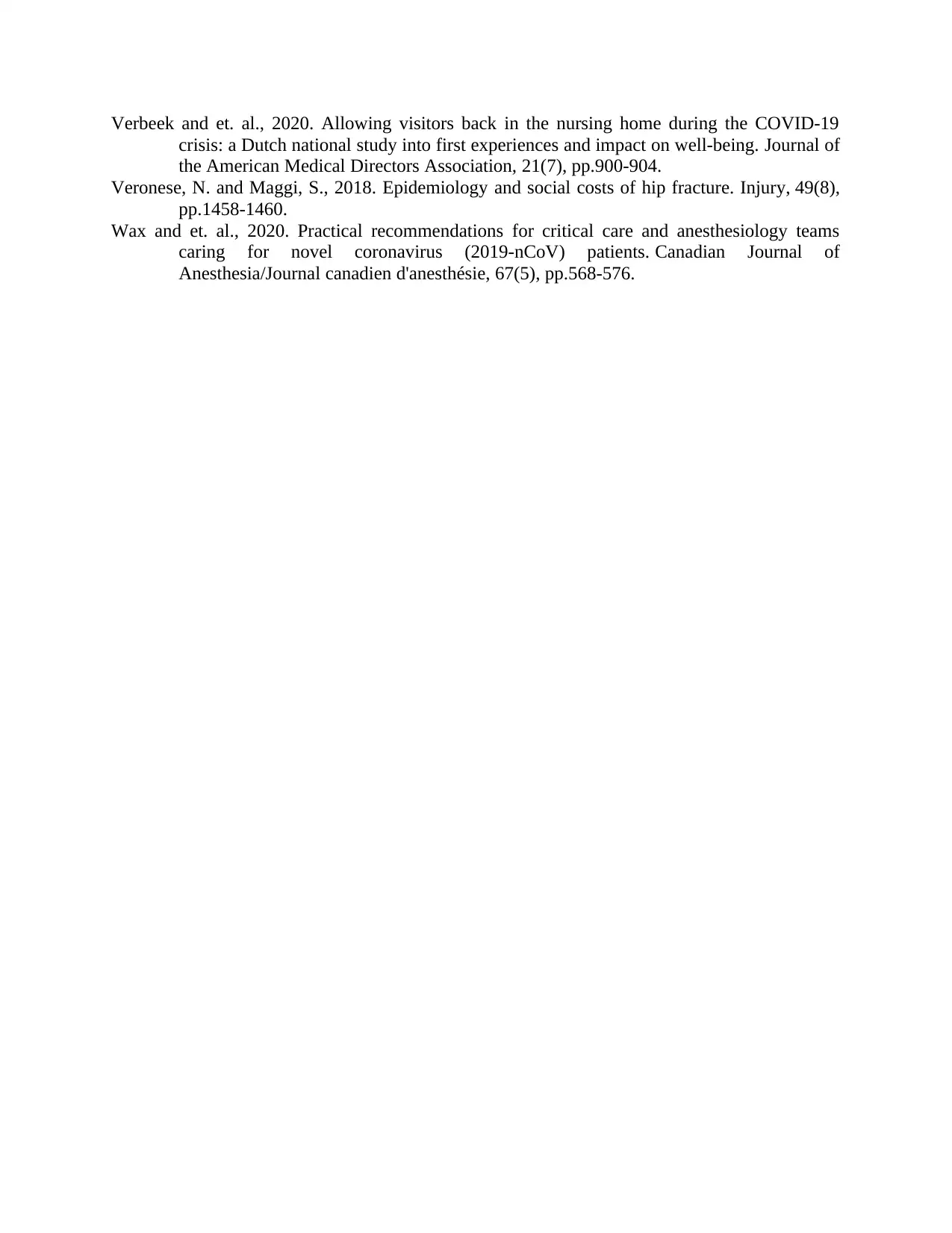
Verbeek and et. al., 2020. Allowing visitors back in the nursing home during the COVID-19
crisis: a Dutch national study into first experiences and impact on well-being. Journal of
the American Medical Directors Association, 21(7), pp.900-904.
Veronese, N. and Maggi, S., 2018. Epidemiology and social costs of hip fracture. Injury, 49(8),
pp.1458-1460.
Wax and et. al., 2020. Practical recommendations for critical care and anesthesiology teams
caring for novel coronavirus (2019-nCoV) patients. Canadian Journal of
Anesthesia/Journal canadien d'anesthésie, 67(5), pp.568-576.
crisis: a Dutch national study into first experiences and impact on well-being. Journal of
the American Medical Directors Association, 21(7), pp.900-904.
Veronese, N. and Maggi, S., 2018. Epidemiology and social costs of hip fracture. Injury, 49(8),
pp.1458-1460.
Wax and et. al., 2020. Practical recommendations for critical care and anesthesiology teams
caring for novel coronavirus (2019-nCoV) patients. Canadian Journal of
Anesthesia/Journal canadien d'anesthésie, 67(5), pp.568-576.
1 out of 10
Related Documents
Your All-in-One AI-Powered Toolkit for Academic Success.
+13062052269
info@desklib.com
Available 24*7 on WhatsApp / Email
![[object Object]](/_next/static/media/star-bottom.7253800d.svg)
Unlock your academic potential
© 2024 | Zucol Services PVT LTD | All rights reserved.





